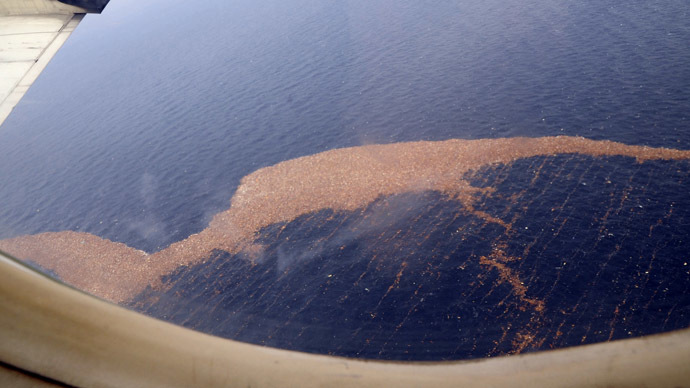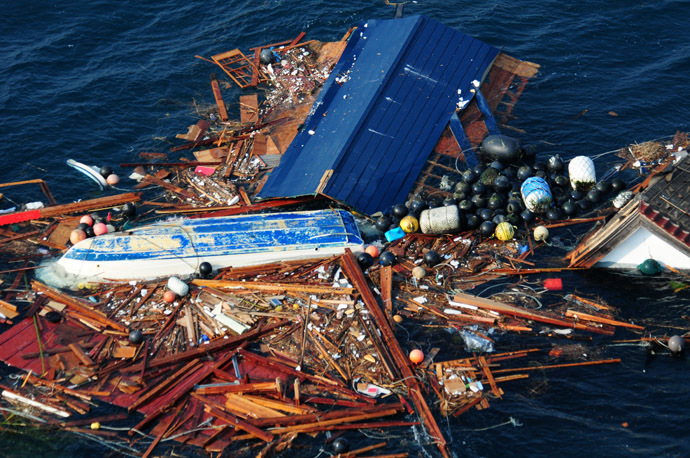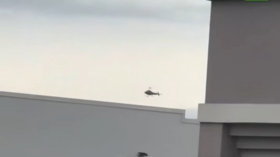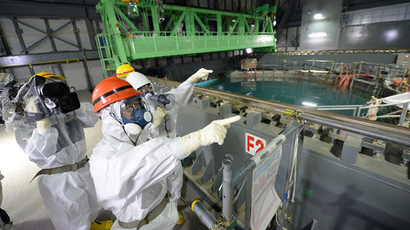1 million tons of Fukushima debris floating near US West Coast?

Over a million tons of Fukushima debris could be just 1,700 miles off the American coast, floating between Hawaii and California, according to research by a US government agency.
The National Oceanic and Atmospheric Administration (NOAA)
recently updated its report on the movement of the Japanese
debris, generated by the March 2011 tsunami, which killed 16,000
people and led to the Fukushima nuclear power plant meltdown.
Seventy percent of an estimated 5 million tons of debris sank
near the coast of Japan, according to the Ministry of
Environment. The rest presumably floated out into the Pacific.
While there are no accurate estimates as to where the
post-tsunami junk has traveled so far, the NOAA has come up with
a computer model of the debris movement, which gives an idea of
where its highest concentration could be found.
That area is crosshatched at the NOAA model below and resembles
an island quite near the US shore.

The NOAA graphics have led to numerous media reporting about an
island of rubbish moving towards the US.
The agency was forced to alleviate the concerns in an article
saying there was “no solid mass of debris from Japan heading
to the United States.”
“At this point, nearly three years after the earthquake and
tsunami struck Japan, whatever debris remains floating is very
spread out. It is spread out so much that you could fly a plane
over the Pacific Ocean and not see any debris since it is spread
over a huge area, and most of the debris is small, hard-to-see
objects,” NOAA explains on its official webpage.
The agency has stressed its research is just computer simulation,
adding that “observations of the area with satellites have not
shown any debris.”
Despite the fact the tsunami debris is scattered and does not
form a solid mass, the researchers still believe it’s a serious
matter to keep an eye on.

Scientists are particularly interested in the organisms that
could be living on objects from Japan reaching the west coast.
"At first we were only thinking about objects like the
floating docks, but now we’re finding that all kinds of Japanese
organisms are growing on the debris," John Chapman of the
Marine Science Center at Oregon State University told Fox News.
"We've found over 165 non-native species so far," he
continued. "One type of insect, and almost all the others are
marine organisms … we found the European blue mussel, which was
introduced to Asia long ago, and then it grew on a lot of these
things that are coming across the Pacific ... we’d never seen it
here, and we don’t particularly want it here."
The worst-case scenario would be that the trash is housing
invasive organisms that could disrupt the local environment’s
current balance of life. Such was the case in Guam, where earlier
this year it was announced that the US government intended to
parachute dead mice laced with sedatives on to the island in
order to deal with an invasive species of brown tree snake that
was believed to have been brought to the American territory on a
military ship over 60 years ago. In a little over half a century,
a few snakes spawned what became an estimated 2 million animals,
the likes of which ravaged the island’s native bird population
and warranted government intervention.
Other concerns such as radiation, meanwhile, have been
downplayed. On its website, the NOAA says, “Radiation experts
agree that it is highly unlikely that any tsunami-generated
marine debris will hold harmful levels of radiation from the
Fukushima nuclear emergency.”
Independent groups like the 5 Gyres Institute, which tracks
pollution at sea, have echoed the NOAA’s findings, saying that
radiation readings have been “inconsequential.” Even the release
of radioactive water from the Fukushima nuclear reactor shouldn't
be a grave concern, since scientists say it will be diluted to
the point of being harmless by the time it reaches American
shores in 2014.














